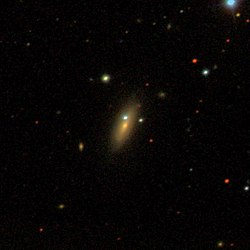NGC 7508
| Galaxie NGC 7508 | |
|---|---|
 | |
| SDSS-Aufnahme | |
| AladinLite | |
| Sternbild | Pegasus |
| Position Äquinoktium: J2000.0, Epoche: J2000.0 | |
| Rektaszension | 23h 11m 49,2s [1] |
| Deklination | +12° 56′ 26″ [1] |
| Erscheinungsbild | |
| Morphologischer Typ | S[1] |
| Helligkeit (visuell) | 14,8 mag[2] |
| Helligkeit (B-Band) | 15,6 mag[2] |
| Winkelausdehnung | 1,0' × 0,3'[2] |
| Positionswinkel | 160°[2] |
| Flächenhelligkeit | 13,3 mag/arcmin²[2] |
| Physikalische Daten | |
| Rotverschiebung | 0,040611[1] |
| Radialgeschwindigkeit | 12,175 km/s[1] |
| Hubbledistanz H0 = 73 km/(s • Mpc) | (551 ± 38) · 106 Lj (169,0 ± 11,8) Mpc [1] |
| Geschichte | |
| Entdeckung | John Herschel |
| Entdeckungsdatum | 13. Oktober 1825 |
| Katalogbezeichnungen | |
| NGC 7508 • UGC 12408 • PGC 70663 • CGCG 431-011 • MCG +02-59-005 • 2MASX J23114919+1256255 • | |
NGC 7508 ist eine Spiralgalaxie vom Hubble-Typ S im Sternbild Pegasus am Nordsternhimmel. Sie ist schätzungsweise 551 Millionen Lichtjahre von der Milchstraße entfernt und hat einen Durchmesser von etwa 160.000 Lichtjahren. Im selben Himmelsareal befinden sich u. a. die Galaxien NGC 7505, NGC 7511, NGC 7515, NGC 7536.
Das Objekt wurde am 13. Oktober 1825 von John Herschel entdeckt.[3]
Weblinks
Einzelnachweise
Auf dieser Seite verwendete Medien
Autor/Urheber: Sloan Digital Sky Survey, Lizenz: CC BY 4.0

Angle of view: 4' × 4' (0.3" per pixel), north is up.
Details on the image processing pipeline: https://www.sdss.org/dr14/imaging/jpg-images-on-skyserver/